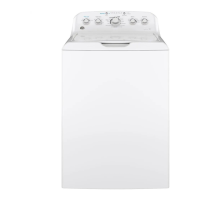Why does the water level seem low in my GE GTW465?
- Ccynthia39Sep 1, 2025
If the water level seems low in your GE Washer, it's normal for this high-efficiency washer, water may not cover the top level of the clothes.

Why does the water level seem low in my GE GTW465?
If the water level seems low in your GE Washer, it's normal for this high-efficiency washer, water may not cover the top level of the clothes.
What to do if my GE GTW465 won’t drain?
If your GE Washer isn’t draining, make sure the drain hose isn't kinked or that the washer isn't sitting on it. The top of the drain outlet should be less than 8 ft (2.44 m) above the floor. Straighten the drain hose and ensure proper connection.
Why are my clothes too wet after washing in my GE GTW465 Washer?
If clothes are coming out of your GE Washer too wet, ensure that the cycle selected matches the load you are washing. Some fabrics will feel wetter when rinsed with cold water. If the wash load is out of balance, redistribute the load in the washer and run it through a Drain & Spin cycle.
Why does the agitator seem loose on my GE GTW465 Washer?
If the agitator seems loose on your GE Washer (on some models), it is designed to be flexible to allow for care of large bulky items such as comforters; this is normal.
How to fix a GE GTW465 Washer that won't operate?
If your GE Washer isn't operating, here are a few things to check: * Make sure the power cord is securely plugged into a working outlet. * Ensure both hot and cold water faucets are fully turned on. * Confirm that the lid is closed and press Start, as a safety feature prevents operation when the lid is open. * Check your house's circuit breakers or fuses and replace if necessary. The washer should ideally have its own separate outlet. * Try resetting the electronics by unplugging the washer, waiting two minutes, plugging it back in, and then pressing Start. * Ensure you have pressed the Start button.
What to do if my GE Washer is leaking water?
If your GE washer is leaking water, consider the following: * Switch to High Efficiency detergent. * Use less detergent, especially if you have soft water or a lightly soiled load. * Ensure fill and drain hoses are tightly connected at the faucets and that rubber washers are installed. Also, verify the drain hose is correctly inserted and secured to the drain. * Check your household plumbing for clogs; a plumber might be needed. * Ensure the drain hose isn't rubbing against the wall to prevent wear. * Tighten the hoses at the faucets and inspect the fill hoses, replacing them every 5 years if necessary.
Why are there snags, holes, tears, rips or excessive wear on my clothes after washing in my GE Washer?
Snags, holes, tears, rips, or excessive wear on clothes after washing in your GE washer can occur due to: * Pins, snaps, hooks, sharp buttons, belt buckles, zippers, and sharp objects left in pockets. Fasten snaps, hooks, buttons, and zippers. Remove loose items like pins, objects in pockets, and sharp buttons. Turn knits (which snag easily) inside out. * Undiluted chlorine bleach. Check the bleach package instructions for the proper amount and never add undiluted bleach to the wash or allow clothes to come into contact with undiluted bleach. * Chemicals like hair bleach or dye, or permanent wave solution. Rinse items that may have chemicals on them before washing and use the Speed Wash cycle with the Extra Rinse option (on some models).
Why are laundry additives dispensing too soon in my GE GTW465 Washer?
If you're experiencing laundry additives dispensing too soon in your GE Washer (on some models), avoid overfilling the dispensers or adding water to them. When using fabric softener, select the Deep Rinse/Extra Rinse option.
Why is my GE GTW465 Washer rocking or moving?
If your GE Washer is rocking or moving, it's likely due to uneven leveling legs. To fix this, adjust the leveling legs by rotating each leg in the proper direction until the washer is stable.
Why does my GE Washer make a “squeaking” sound?
If you hear a “squeaking” sound from your GE Washer, it could be that the washer isn't level and is rubbing on the cabinet. To fix this, adjust the leveling legs by rotating each leg in the proper direction until the washer is stable.
| Appliance Category | Washer |
|---|---|
| Washer Type | Top Load |
| Capacity | 4.5 cu. ft. |
| Color | White |
| Maximum Spin Speed | 700 RPM |
| Energy Star Certified | Yes |
| Voltage | 120 V |
| Wash Cycles | Bulky Items; Colors; Delicates; Quick Wash; Rinse & Spin; Soak; Whites |
| Spin Speeds | High, Medium, Low |
| Water Temperature Settings | Hot, Warm, Cold |
| Width | 27 in |
| Height | 44 in |
| Depth | 27 in |
Key safety warnings and precautions for operating the appliance.
Ensuring safe installation, grounding, and electrical connections for the washer.
Safe procedures for starting, draining, and storing the washing machine.
Matching laundry items to the appropriate wash cycles for optimal cleaning.
Essential preparation steps, tools, and parts needed for washer installation.
Specifications for water supply pressure, temperature, and drain connection.
Details on electrical power supply, circuit, and proper grounding procedures.
Solutions for common issues like low water level, leaks, and temperature problems.
Details on the warranty period, what is covered, and replacement policies.
Exclusions from warranty coverage, limitations on implied warranties, and legal rights.
